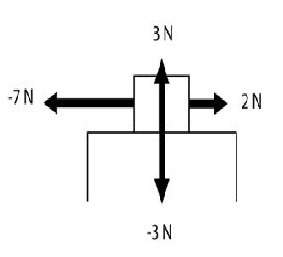Forces: what’s going to happen?
take a look at this box and the forces acting on it.
...

Forces: what’s going to happen?
take a look at this box and the forces acting on it.
box with forces acting on it
will the box move, and if so, how will it move? answer the following questions.
1. first, determine the net force acting on the box.
2. if the net force is equal to zero, would the box move? if so, how would it move? explain.
3. if there is a nonzero net force acting on the box, would the box move? if so, how would it move? explain.
4. based on the net force you found for the box, how will this box move?


Answers: 1
Another question on Physics

Physics, 21.06.2019 20:30
F500 j of energy were added to 1 kg of each of these samples, which would experience the least temperature increase?
Answers: 2

Physics, 22.06.2019 05:30
Acombination reaction is when two or more combine to form one product. a decomposition reaction is when a substance breaks down into two or more simpler substances in a chemical reaction.
Answers: 1

Physics, 22.06.2019 08:30
Red’s momentum vector before the collision is green’s momentum vector after the collision. question 1 options: equal to shorter than longer than question 2 (1 point) saved since green bounces off red, this must be an collision. question 2 options: explosion elastic inelastic question 3 (1 point) red transfers of its momentum to green during the collision. question 3 options: none all little most question 4 (4 points) why does red transfer all its momentum to green? back up your answer with information from the simulation. write at least 2 sentences. question 4 options: skip toolbars for . more insert actions. more text actions. more paragraph style actions. question 5 (1 point) now make red much heavier than green. answer the questions below to describe how both red and green behave after the collision. question 5 options: slowed down sped up kept the same velocity question 6 (1 point) green sped up during the collision as it question 6 options: gained momentum from red lost momentum to red maintained a constant momentum. question 7 (1 point) after the collision . . question 7 options: both green and red moved to the right. both green and red stopped as they have lost all momentum. red stopped and green moved to the right. red bounced off green and went to the left. green moved to the right. question 8 (4 points) only some of red’s momentum was transferred to green. why did this occur? back up your answer with information from the simulation. write at least 2 sentences. question 8 options: skip toolbars for . more insert actions. more text actions. more paragraph style actions. question 9 (1 point) now make red much lighter than green. answer the questions below to describe how both red and green behave after the collision question 9 options: green sped up after the collision therefore it must have gained momentum. green sped up after the collision therefore it must have lost momentum. green slowed down after the collision therefore it must have gained momentum. green slowed down after the collision therefore it must have lost momentum. question 10 (1 point) since green gained momentum, red had to have momentum because you cannot create or destroy momentum. question 10 options: gained lost kept the same amount of question 11 (1 point) since green was so much and harder to move, it caused red to bounce back to the left giving red . question 11 options: heavier . . . . positive lighter. . . . negative lighter. . . . positive heavier . . . . negative question 12 (4 points) now, click on more data at the bottom of the sim. play with different numbers for the masses and starting velocities. you can even make the starting velocities negative! tell me one thing you discovered by adjusting the speeds and masses. write at least 2 sentences. be specific and use words like velocity, momentum, mass, increased, decreased, etc. 13. true or false: when red and green collide, they stick together. question 13 options: true false question 14 (1 point) the velocity of red & green after the collision is the velocity that red started off with. question 14 options: larger than smaller than equal to question 15 (1 point) the velocity after the collision was less because the mass has question 15 options: stayed the same decreased increased question 16 (1 point) the momentum before the collision was the momentum after the collision. question 16 options: larger than smaller than equal to conclusions question 17 (4 points) how are elastic and inelastic collisions different? give two or more ways. your answer should have at least 2 sentences. question 18 (4 points) give an example of a collision in real life. use the law of conservation of energy to describe the transfer of momentum. be sure and discuss the momentum before and after the collision occurs. you will need at least 3 sentences to thoroughly answer this question.
Answers: 2

Physics, 22.06.2019 12:10
Does anyone have the answers to online physics course plato course physics, semester a v3.0
Answers: 2
You know the right answer?
Questions


Social Studies, 10.07.2019 05:30





Mathematics, 10.07.2019 05:30




Mathematics, 10.07.2019 05:30






Biology, 10.07.2019 05:30


French, 10.07.2019 05:30




